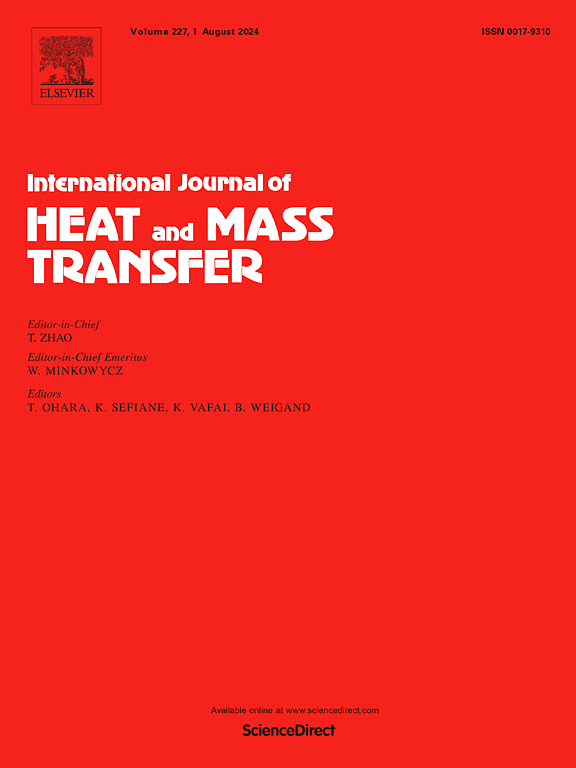Heat transfer enhancement for electro-thermo-convection of FENE-P viscoelastic fluid in a square cavity
IF 5
2区 工程技术
Q1 ENGINEERING, MECHANICAL
International Journal of Heat and Mass Transfer
Pub Date : 2024-11-08
DOI:10.1016/j.ijheatmasstransfer.2024.126390
引用次数: 0
Abstract
This study numerically investigates the heat transfer enhancement for viscoelastic electro-thermo-convection in a two-dimensional differentially heated cavity with injection from below. The flow motion is assumed to be incompressible, which is driven by the Coulomb force and the thermal buoyant force. The polymers are described by the FENE-P model which exhibits typical shear-thinning and elastic properties. Based on the extensibility parameter (), the cases are divided into several scenarios, corresponding to weak elasticity with strong shear-thinning, moderate elasticity with moderate shear-thinning, and strong elasticity with weak shear-thinning, respectively. We find that the competition between the shear-thinning and elasticity dominates the flow state and heat transport. The shear-thinning effect tends to facilitate heat transfer, while its elastic properties tend to decrease it. In the scenario of weak elasticity with strong shear-thinning (), the polymer additives significantly improve the heat transfer enhancement (HTE) of the electric field as the polymer viscosity ratio () decreases or Weissenberg number () increases, where the maximum HTE reaches around 92.1%. The amount of HTE first increases rapidly with but then remains almost constant once a critical is exceeded. However, the HTE significantly decreases in the scenario of strong elasticity with weak shear-thinning () since the elasticity dominates over the shear-thinning. These heat transfer performances are then corroborated with the boundary layer and kinetic energy budget analysis.
方形空腔中 FENE-P 粘弹性流体电热对流的传热增强效应
本研究以数值方法研究了粘弹性电热对流在自下而上注入的二维差热空腔中的传热增强问题。假设流动运动不可压缩,由库仑力和热浮力驱动。聚合物由 FENE-P 模型描述,该模型具有典型的剪切稀化和弹性特性。根据延伸性参数 (L),情况被分为几种,分别对应于弱弹性与强剪切稀化、中等弹性与中等剪切稀化以及强弹性与弱剪切稀化。我们发现,剪切稀化和弹性之间的竞争主导了流动状态和热量传输。剪切稀化效应倾向于促进热传递,而其弹性特性则倾向于降低热传递。在弹性弱、剪切稀化强(L2=10)的情况下,随着聚合物粘度比(β)的降低或魏森伯格数(Wi)的增加,聚合物添加剂可显著改善电场的传热增强(HTE),其中最大 HTE 约为 92.1%。HTE 量先是随着 Wi 的增加而迅速增加,但一旦超过临界 Wi,HTE 量就几乎保持不变。然而,在强弹性和弱剪切稀化(300≤L≤1000)的情况下,由于弹性比剪切稀化占优势,因此 HTE 明显降低。边界层和动能预算分析证实了这些传热性能。
本文章由计算机程序翻译,如有差异,请以英文原文为准。
求助全文
约1分钟内获得全文
求助全文
来源期刊
CiteScore
10.30
自引率
13.50%
发文量
1319
审稿时长
41 days
期刊介绍:
International Journal of Heat and Mass Transfer is the vehicle for the exchange of basic ideas in heat and mass transfer between research workers and engineers throughout the world. It focuses on both analytical and experimental research, with an emphasis on contributions which increase the basic understanding of transfer processes and their application to engineering problems.
Topics include:
-New methods of measuring and/or correlating transport-property data
-Energy engineering
-Environmental applications of heat and/or mass transfer

 求助内容:
求助内容: 应助结果提醒方式:
应助结果提醒方式:


